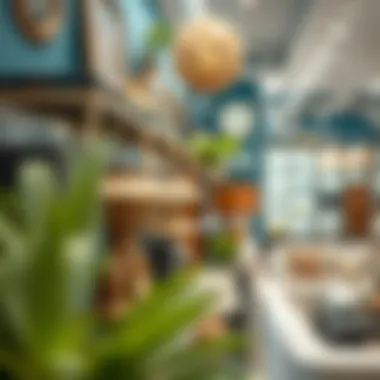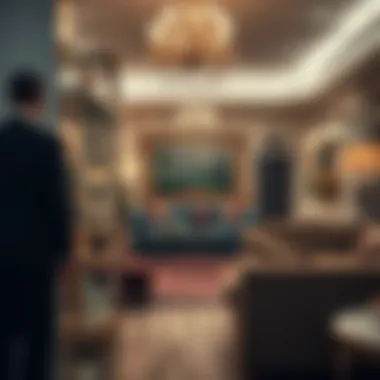Navigating the Furniture Shops of Karama, Dubai


Intro
Karama, a bustling community in Dubai, is not just known for its vibrant street life and diverse culture but also for its eclectic furniture shops. If you take a stroll through its streets, you might find shops that offer anything from traditional wooden designs to contemporary minimalistic pieces. The furniture scene here represents much more than mere craftsmanship; it embodies the tastes, goals, and lifestyles of an ever-evolving urban populace.
Why Explore Furniture in Karama?
The inquiry into Karama's furniture shops isn't purely about aesthetics. By understanding the variety and trends present, investors and consumers can make informed decisions, ensuring that their choices resonate with individual style preferences while also potentially enhancing property values in the area. This article seeks to uncover various elements influencing consumer behaviors, illuminate noteworthy stores, and elucidate the market dynamics at play.
In a world where styles constantly evolve, staying ahead of the trend can mean the difference between a wise investment and a regrettable purchase. As such, the relevance of this topic extends well beyond the home décor—it reaches into the realms of property investments, especially in areas like Karama where design meets functionality.
Here, we will also explore market trends, consider property investment insights, and equip potential buyers and real estate aficionados with the knowledge they need to navigate this dynamic landscape.
The Audience
This discourse primarily caters to investors seeking insight into the local market, expats looking to furnish their new homes, agents wanting to understand client needs, managers enhancing corporate spaces, and buyers aiming to make informed choices. Each section interlaces these perspectives, presenting a comprehensive guide that reflects the intricacies of the furniture shop landscape in Karama.
Preface to Furniture Shopping in Karama
Furniture shopping in Karama is not just about filling a home with items, but rather a unique experience that reflects the evolving tastes and preferences of its diverse community. Karama, nestled in Dubai, is a neighborhood that embodies a melting pot of cultures, making the furniture landscape vibrant and multifaceted.
Importance of the Topic
Understanding the furniture shop landscape in Karama holds significance for several reasons. For investors, this area is often perceived as a ground zero for potential growth. The influx of expatriates and locals looking to decorate their homes leads to a robust demand for furniture. Consequently, this demand is an indication of market viability and is essential for investment decisions.
For expats, particularly those new to Dubai, navigating the myriad of options can be overwhelming. Shops vary from local boutiques filled with handmade and traditional pieces to international brands showcasing modern designs. This variety offers consumers numerous style choices that cater to different tastes and budgets.
Benefits and Considerations
Shopping in Karama allows consumers to discover furniture that’s not only functional but also imbued with stories from various cultures. Here are some essential aspects worth noting:
- Affordability: Many local shops provide quality pieces at competitive prices, making it feasible for families on a budget to furnish their homes elegantly without breaking the bank.
- Unique Pieces: Local artisans contribute to the scene with bespoke items that may not be found elsewhere, making each piece potentially significant to its owner.
- Cultural Resonance: The influence of local traditions and practices in furniture styles offers a touch of authenticity. Pieces often tell stories of heritage, reflecting the community’s values and aesthetics.
"In Karama, furniture isn't just an object; it embodies a narrative that connects people to their roots and aspirations."
Culmination
Historical Context
Understanding the historical context of furniture shopping in Karama provides valuable insight into the neighborhood's evolution and its vibrant market today. This context serves as a foundation for determining what consumers now seek in furniture stores, influenced by both local traditions and modern trends. As Karama has developed, so too have its shops, making it essential to grasp the past to appreciate current offerings.
The Evolution of Karama
Karama’s transformation from a modest locality into a bustling community reflects broader economic and cultural shifts. Originally established in the mid-20th century as a residential area for expatriates and a melting pot of cultures, it gradually attracted various businesses, including those in the furniture sector. By the early 2000s, the rise in population, especially among families and professionals, surged demand for both basic and luxurious furnishings.
Looking at the timeline, one can see key milestones:
- Early years (1960-1980): The area featured small, family-owned shops; local craftsmanship characterized furniture offerings.
- 2000s expansion: Global brands began entering the market, catering to a broader demographic. This led to a mix of modern styles with traditional designs.
- Recent trends: Increasing preference for eco-friendly and sustainable furniture has emerged, shaping newer stores dedicated to these ideals.
This evolution illustrates how Karama's furniture landscape has grown from simple roots to a complex, diverse market. Consequently, it plays a significant role in not only satisfying consumer needs but also in shaping cultural identity in a constantly changing urban environment.
Cultural Influences on Furniture Styles
Karama's furniture styles are a tapestry woven from various cultural threads. The blend of expatriate communities—Indians, Pakistanis, Arabs, Westerners—contributes to a diverse aesthetic palette. Each culture introduces elements reflecting its heritage and lifestyle. For example:
- Middle Eastern designs often feature intricate woodwork and vibrant colors, symbolizing warmth and hospitality.
- Contemporary Western styles generally lean towards minimalism, emphasizing clean lines and functional use of space.
- South Asian influences introduce eclectic textiles and bold patterns, making spaces visually dynamic.


As these different styles mesh, they encourage consumers to explore and adopt unique combinations in their homes. Additionally, cultural festivals, such as Eid and Diwali, see an uptick in sales, as families decorate their homes to welcome guests.
Karama's furniture shops not only provide goods but also act as cultural hubs where diverse inspirations meet, ensuring that furniture there tells a story of its own. As purchasers gravitate towards pieces that resonate with their identities, the market reflects not just a transactional relationship but rather an emotional one steeped in shared history and tradition.
"Furniture is not just about functionality; it's about creating a home that tells your story."
Having recognized how history shapes today's consumer choices, we can better appreciate the diverse shopping experience in Karama, making it increasingly relevant for buyers, investors, and all stakeholders in the property industry.
Types of Furniture Shops
The furniture shop landscape in Karama is both rich and diverse, with various offerings that cater to different tastes, budgets, and functional needs. In understanding the types of furniture shops available, one gains insight into the dynamics of this market that not only reflects consumer preferences but also impacts the aesthetic and financial value of living spaces. For buyers, knowing what types of shops exist can guide their shopping experience effectively, ensuring they find the right pieces to complement their homes.
Local Stores vs. International Brands
When it comes to furniture shopping in Karama, the debate between local stores and international brands is significant. Each has its own merits that cater to distinct segments of the market.
Local stores, often family-owned, hold a certain charm and familiarity. Many of them offer handmade or locally sourced pieces that tell a story of the cultural influences in Dubai. This personal touch can mean better customer service as store owners are usually deeply engaged in the local community. Shoppers may find unique items that reflect the area's character, which is a benefit often lost in mass-produced international brands.
On the other hand, international brands bring a level of professionalism and reliability that appeals to expatriates and those looking for standardized quality. Stores like IKEA or Mobilia provide extensive options, well-designed pieces, and a sense of familiarity to the expat community. When a buyer walks into these shops, there’s an assurance that they will find something fitting, from minimalist designs to expansive suites of classic furniture.
It's also worth noting that international brands frequently follow the latest global trends in furniture design, which can be a double-edged sword, as it may lead to a homogeneity of aesthetic appeal across different regions. In contrast, local shops tend to incorporate traditional elements that can add character and warmth to modern homes. Overall, both types of shops are essential in Karama's diverse furniture market, each offering valuable choices for different segments of consumers, allowing them to make informed decisions based on their preferences.
Specialty Stores and Unique Offerings
Beyond the general category of local and international shops, Karama is home to specialty stores offering unique furniture pieces that appeal to niche markets. These shops often focus on specific styles, materials, or purposes—crafting a shopping experience that is tailored rather than general.
For instance, some shops specialize in antique furniture, attracting collectors and those interested in historical pieces with character. The allure of aged wood and craftsmanship in vintage pieces can redefine a living space, adding depth and narrative. Specialty stores may also feature boutique selections of eco-friendly furniture, targeting the growing awareness of sustainability among consumers. Furniture made from recycled materials or sustainably sourced woods presents an attractive option for the environmentally-considerate shopper.
Moreover, many of these stores provide custom design services. This is especially beneficial for those who are keen on personalizing their living space but lack the time or wherewithal to put the elements together. Designers work closely with customers to create pieces that fit their specific needs, ensuring a perfect match for aesthetics and functionality.
Consumer Preferences
Navigating the furniture scene in Karama cannot be done without acknowledging the significance of consumer preferences. These preferences reveal the psychological and practical dimensions of purchasing decisions within the bustling neighborhood. People often seek furniture that speaks to their personal style and functional needs, thus influencing the types of shops that flourish in the area.
Trends in Design Preferences
When it comes to trends, consumers in Karama tend to favor a harmonious blend of aesthetics and comfort. The ongoing global influence of minimalist design can be observed in many households, with light colors and simple lines garnering respect. Lately, there has been a tendency towards mid-century modern styles, which echo a nostalgic yet trendy vibe.
- Neutral Color Palettes: Shades of white, beige, and light gray dominate current choices, promoting brightness and a sense of spaciousness, particularly in compact living spaces typical of Karama.
- Natural Materials: From reclaimed wood to organic fabrics, there’s a strong inclination towards materials that feel authentic. This trend not only enhances the look but also connects with principles of sustainability, thus bridging personal style with wider societal values.
In addition, the availability of customization options is crucial. Shoppers appreciate stores that allow them to tailor pieces according to their tastes, be it through upholstery selections or specific measurements. This trend reflects a drive towards distinctive personalization, as people want their living environments to be unique.
Sustainability and Eco-Friendly Options
As eco-consciousness rises among consumers, the demand for sustainable and eco-friendly furniture options has seen a spotlight in Karama's market. More people are opting for brands that prioritize green practices, whether it's through materials, manufacturing, or shipping. The significance of this movement is evident, as consumers increasingly value transparency from brands regarding their environmental impacts.
- Recycled Materials: Furniture made from reclaimed or recycled materials not only reduces waste but also tells a story. Shoppers often gravitate towards pieces that have a character, which enhances the narrative of their homes.
- Ethical Sourcing: Consumers are keen on understanding the origins of the materials they bring into their living spaces. Brands that emphasize fair trade and ethical sourcing attract clientele who are aware of their purchase decisions and the implications of those choices.
As a conclusion to consumer preferences in Karama, it is clear that buyers are not just looking for functionality; they seek pieces that resonate with their values and lifestyles. Understanding these preferences allows store owners and designers to cater more effectively to the market, thereby enhancing customer satisfaction and loyalty.
Market Trends Affecting Karama's Furniture Sector
Understanding the market trends that affect the furniture sector in Karama is essential for anyone involved in this industry, from buyers and investors to local shop owners and real estate agents. This landscape is dynamic, characterized by shifting consumer preferences, technology advancements, and broader economic factors.* Grasping these trends helps stakeholders make informed decisions in a competitive environment.
Impact of Economic Factors


The economy plays a vital role in shaping how the furniture market evolves in Karama. When economic conditions are favorable, consumers typically have more disposable income to spend on furniture, which in turn, drives demand.
- Income Levels: High-income levels often correlate with a greater inclination to purchase premium or luxury items. In contrast, economic downturns can lead to frugality, pushing consumers towards budget-friendly options.
- Inflation and Cost of Living: As costs for basic necessities rise, it can lead to budget constraints. In such situations, shoppers might opt for sales or discounted items, influencing inventory choices.
- Property Market Trends: With Karama being a vibrant neighborhood in Dubai, trends in real estate can significantly affect how furniture is sold. An increase in property sales or rentals creates corresponding demand for furniture, as new homeowners or tenants seek to furnish their spaces. Furthermore, as new developments sprout, showing prospective investors or tenants that the market is thriving adds another layer of urgency, driving quicker purchasing decisions.
Noteworthy Furniture Shops in Karama
When delving into the furniture scene of Karama, it’s impossible to overlook noteworthy shops that shape the local aesthetic and cater to the diverse tastes of residents and newcomers alike. These establishments do not only fill homes with furniture but also encapsulate the spirit of Karama itself, blending tradition with modernity, style with functionality. Consumers look for shops where they can find more than just products; they seek places that resonate with their personal stories, reflect their lifestyles, and often stand as a testament to their choices as homeowners or investors.
Focusing on these shops offers valuable insights into current consumer preferences while providing potential investors an understanding of the local market dynamics. These locations can become hotspots of inspiration for homeowners looking to create a specific ambiance or even for real estate agents seeking to advise clients on staging properties effectively.
Shop Features and Offerings
In Karama, the furniture shops vary tremendously, offering everything from traditional wooden craftsmanship to contemporary minimalist designs. Here, intriguing features include:
- Custom-made Furniture: Many shops offer bespoke options, allowing clients to tailor pieces according to their specifications. This trend is catching on fast, especially among expats wishing to add a personal touch to their homes.
- Sustainable Choices: A growing number of stores are going green, providing eco-friendly furniture solutions. For instance, bamboo-based shelves and recycled metal chairs can be seen popping up more frequently.
- Import Varieties: Several notable shops pride themselves on sourcing international furniture. By doing so, they bring an eclectic flair to their collections that captivate a wide audience.
- Accessories and Décor: Beyond just essential furniture, many establishments carry complementary items like rugs, artwork, and lamps. This addition not only enhances customer experience but also allows them to see a more complete vision of their potential living spaces.
The immersive experience of visiting these shops is essential for buyers; they can see, touch, and feel the furniture, which is something online shopping often lacks. Many places have thoughtfully arranged showrooms, allowing customers to visualize how items might fit into their own homes.
Customer Experiences and Reviews
The experiences of shoppers at Karama's furniture outlets highlight the significance of personal interaction in the buying process. Positive customer reviews often emphasize:
- Knowledgeable Staff: Many shoppers appreciate staff who not only sell but offer guidance based on years of experience or product knowledge. Customers relish personal interactions that help in choosing the right pieces.
- Post-Purchase Services: Several stores offer delivery and assembly services, which can be a lifesaver for customers who are busy or unfamiliar with DIY tasks. A recommendable shop will always ensure that the customer’s newfound investment arrives safely and is set up correctly.
- Return Policies: Things don't always go as planned, so having a flexible return policy often wins consumer loyalty. Buyers feel reassured knowing they have options should the piece not meet their expectations once they’re home.
Overall, reviews can be a treasure trove of information for those considering furniture purchases. Reading through existing customer feedback gives insight into potential pitfalls and celebrated successes with specific shops.
"Shopping for furniture in Karama isn’t just about getting a sofa; it’s about crafting a home experience that’s uniquely yours."
In summation, noteworthy furniture shops in Karama are more than mere retail spaces; they are integral threads in the fabric of the community. They reflect the evolving tastes and needs of buyers while remaining sources of inspiration and a touchpoint for much broader discussions about lifestyle, design, and personal expression.
Buying Considerations
When it comes to purchasing furniture, many factors come into play. For consumers in Karama, understanding the various elements involved in buying decisions is crucial. This section delves into the financial and quality-related considerations that can significantly influence your shopping experience.
Budgeting for Furniture Purchases
Setting a budget is a cornerstone of any significant purchase, more so in the world of furniture shopping. With a vast array of options available in Karama, it's all too easy to get swept off your feet and go way overboard financially. Here are some tips to keep your finances in check:
- Assess Your Needs: Start by figuring out what pieces you actually need. Jot down a list—whether it's a comfy sofa, a sleek coffee table, or a dining set. Knowing what you want helps prevent impulse buys.
- Research Prices: Visit various interiors shops and check online platforms to gauge price ranges. Having a ballpark figure will help you manage your expectations.
- Include Additional Costs: Don't forget to factor in delivery fees and assembly costs. Sometimes the price of that gorgeous couch seems right, but once you add the extras, it can put a dent in your budget.
- Set Up a Range: Instead of sticking to a strict number, consider establishing a range. This gives you some flexibility while still keeping you from splurging too much.
Ultimately, a well-planned budget leads to more informed choices, helping you get the best without breaking the bank.
Assessing Quality and Longevity
Once budgeting is out of the way, the focus shifts to the quality of the furniture. In a market like Karama's, where many shops showcase different brands and styles, discerning quality can be challenging but necessary. Here are a few pointers to keep in mind:
- Inspect Materials: Always check what the furniture is made of. Solid wood pieces typically outlast those made from cheaper materials. Look for details on the fabric, cushioning, and frame structure.
- Look for Warranty: Quality items usually come with a warranty or guarantee. This speaks volumes about the manufacturer's confidence in their product.
- Read Reviews: Consumer feedback can provide rich insights into the longevity of a piece. Shops in Karama often have online footprints where you can catch up on customer experiences before making a decision.
- Perform Tests: Don’t hesitate to sit on sofas or open drawers in cabinets as you browse. Physical interaction can reveal much about how durable and comfy a piece might be.
Quality is an investment; purchasing wisely ensures that you're not stuck with furniture that needs replacing after a few months.
When you combine a thoughtful budget with careful consideration of quality, your chances of making a satisfying furniture purchase increase significantly. Understanding these aspects can not only enhance your living space but also contribute to the value of your property in the long run.
The Role of Interior Design
Interior design plays a pivotal role in shaping the aesthetic value and functional appeal of living spaces. In Karama, a neighborhood that blends modernity with tradition, the influence of thoughtful interior design extends well beyond mere decoration; it effects how properties are perceived in the real estate market. Great design doesn't just please the eye; it instills a sense of comfort and harmony within a home or office.


When considering the furniture shop landscape in Karama, one must recognize the interplay between design elements and customer preferences. Interior design is not just about choosing a paint color or arranging furniture; it encompasses a comprehensive understanding of space, light, and the psychology of color. Furniture selections should complement the overall design scheme, enhancing the ambiance while ensuring functionality. As a result, buyers and investors must understand what makes a space more than just a cluster of furniture.
The Impact on Property Value
The impact of interior design on property value is profound and multifaceted. Home buyers frequently seek out properties that resonate with their personal style and needs, making well-designed homes more attractive in the market. For instance, an open floor plan that allows for fluid movement between spaces can elevate a property's marketability.
Moreover, specific design elements such as modern furniture, quality materials, and harmonious color schemes can significantly enhance property value. Developments in the Karama area that showcase these elements often see heightened interest from potential buyers, as they appeal to a demographic that values aesthetic appeal alongside functionality.
"A well-designed space can command a premium and reduce time on the market."
Investors looking into Karama's property market should focus on enhancing interior design features that align with current trends. Areas that present consistent craftsmanship, ergonomic layouts, and sustainable options tend to appreciate more over time. This maximizes return on investment and creates a living space that feels bespoke rather than generic.
Creating Functional Living Spaces
Creating functional living spaces is both an art and a science. A well-designed space takes into account both the physical and emotional needs of its inhabitants. In Karama, where the diverse population includes expats, families, and young professionals, understanding the nuances of functional design is crucial. Every piece of furniture must serve a purpose and contribute positively to the overall experience of the space.
For example, multi-functional furniture is particularly sought after in urban environments like Karama, where space is sometimes at a premium. Items like storage ottomans or expandable dining tables can serve multiple roles, thus maximizing usability without sacrificing style. Furthermore, incorporating local cultural elements into the design can create a unique ambiance that resonates with residents and makes them feel at home.
- Considerations for Functional Spaces:
- Adaptability of furniture to changing needs.
- Use of smart designs that integrate technology more seamlessly.
- Creating zones within open spaces to foster a sense of organization.
In sum, interior design in Karama is more than just aesthetics; it's a critical aspect influencing lifestyle, property value, and personal comfort. As the furniture shops evolve, they will increasingly cater to these design insights, creating an enriched experience for consumers seeking to optimize their spaces.
Renting vs. Buying Furniture
The choice between renting and buying furniture is crucial for anyone navigating the landscape of furniture shopping in Karama. It’s not just about personal style; it's about fitting those choices into a broader context of lifestyle and financial strategy.
When considering renting, many find it ideal for several reasons. Foremost, for short-term stays or transient lifestyles—such as young professionals or expatriates—the flexibility of renting becomes appealing. It provides a temporary solution without the burden of transporting bulky items when moving or the pressure of making long-term decisions. Renting allows individuals to experiment with styles without committing to a hefty investment. Moreover, maintenance and repair responsibilities typically fall on the rental company, easing the burden on the renter.
However, it’s also essential to recognize some drawbacks. Rental agreements might restrict personal expression. Often, there's a limited selection, and inflexible policies can leave tenants feeling trapped in their choices. In addition, over time, the cumulative rental costs can surpass the price of buying furniture outright.
In contrast, buying furniture can be a long-term investment that resonates with individuals looking to establish roots. Owners have the freedom to choose whatever tickles their fancy, allowing for personalized spaces infused with character. Furthermore, owned furniture can effectively increase in value depending on trends and individual care.
Still, it’s not always a straightforward path. Buyers must think about the upfront costs, logistics of delivery, assembly, and maintenance over the years. Additionally, high-quality furniture might require a larger initial financial commitment, but can provide reliable longevity, ultimately saving money in a long-range perspective.
"The decision to rent or buy sets the stage for personalizing living spaces as well as practical financial planning."
In the context of Karama, where housing dynamics vary widely, this decision can be influenced by cultural factors, economic conditions, and individual lifestyle choices. It's about weighing factors like investment benefits against the immediacy of need and versatility of the living situation. Understanding these elements can guide consumers to make informed decisions that align with their preferences and circumstances.
Short-Term vs. Long-Term Needs
Understanding the distinction between short-term and long-term needs is vital when deciding on furniture. Short-term needs are usually dictated by temporary residences or transitional phases in life. Individuals may find themselves moving for work or education. In these situations, renting furniture could be the best fit. You avoid significant upfront costs while maintaining the ability to relocate with ease, focusing solely on your personal belongings.
On the flip side, long-term needs arise when one plans to settle down or invest in a permanent residence. Here, the focus shifts to quality, style, and personal taste. Owning furniture that complements the home structure adds to property value, enhancing lifestyle rather than just filling space.
Evaluating one's situation is key—people need to consider not only how long they’ll be in one place but what kind of atmosphere they wish to create within that timeframe. It’s a balance of practicality and aspiration.
Cost-Effectiveness Analysis
Determining whether to rent or buy furniture often revolves around a thorough cost-effectiveness analysis. For instance, while renting may appear cheaper initially, expenses can add up quickly. Rental fees typically recur monthly and often increase at a contraction's renewal, potentially surpassing the cost of buying furniture after just a couple of years.
Moreover, potential hidden costs come into play, such as damage fees or extra charges for delivery. If one has to constantly replace rented furniture due to wear and tear, it could lead to frustration and increased expense.
Conversely, buying furniture usually requires a larger upfront investment but can lead to great long-term savings. High-quality items are likely to last longer, providing both durability and comfort, making them worth every penny. It also allows for a gradual addition of pieces, spreading out costs over time.
In individual cases, the decision can differ widely based on personal financial circumstances, moving frequency, and commitment levels. Maintaining a clear budget and weighing the benefits against practical implications will guide buyers toward better decisions.
Culmination
For buyers, being well-acquainted with the diverse offerings ranging from local craftsmanship to international brands equips them with the knowledge to make informed decisions. Each item tells a story, whether it's a sleek Scandinavian chair or a handcrafted wooden table echoing Arabic designs. With sustainability becoming a focal point, many shops now feature eco-conscious options, allowing consumers to align their choices with their personal values, merging aesthetics with ethics.
Investors will find Karama's furniture market pulsating with potential. The rise of online shopping in tandem with brick-and-mortar establishments suggests a progressive landscape that appeals to a tech-savvy clientele. Investors should keep an eye on trends such as the popularity of modular furniture that accommodates both small living spaces and lush villas. Such trends can greatly influence property values, thus, understanding consumer preferences becomes a significant advantage for property investors.











